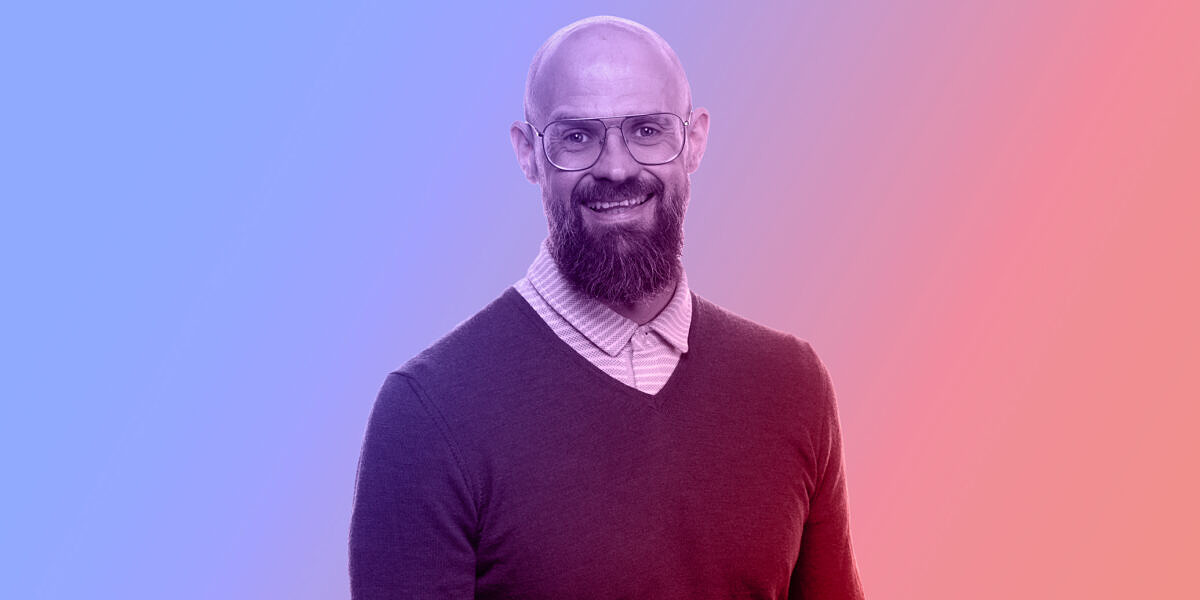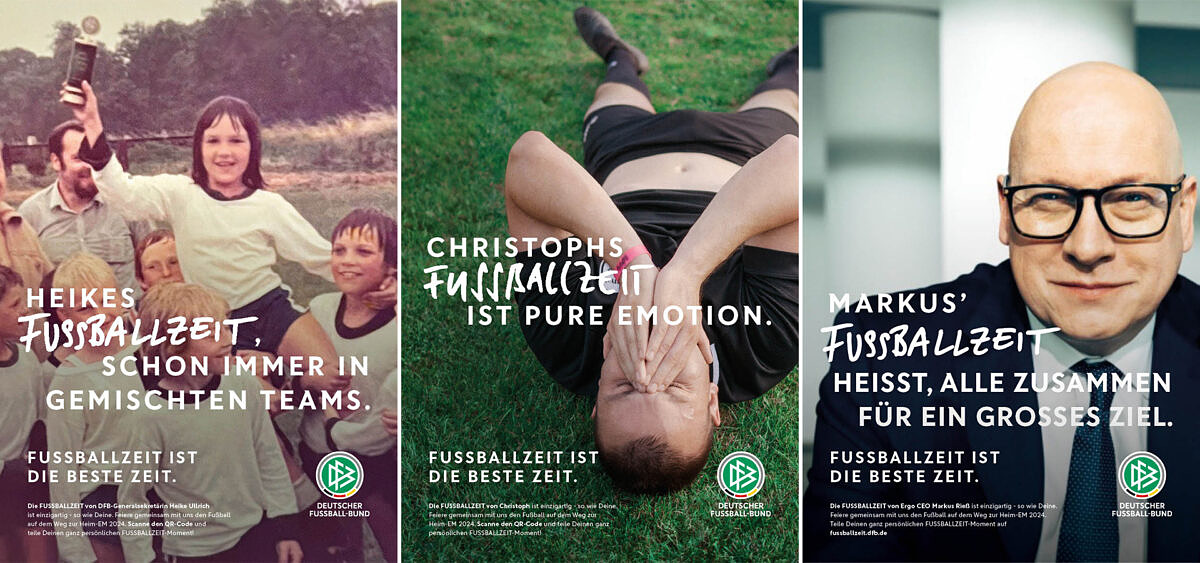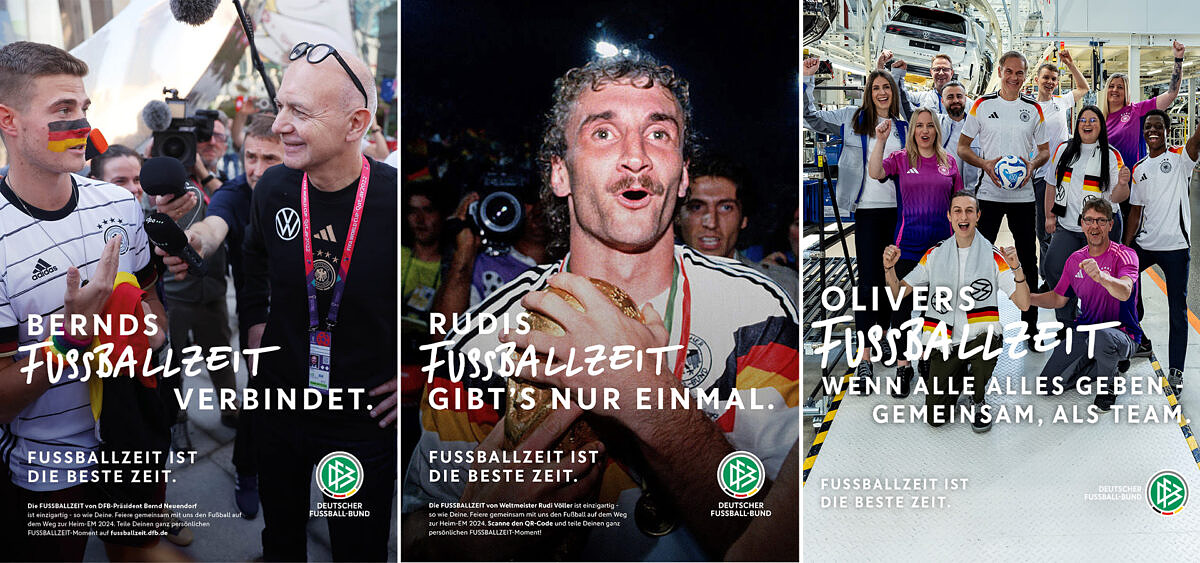DMEXCO interview on the DFB marketing campaign for EURO 2024
“Fussballzeit is the best time” has been the DFB’s slogan over the past few months to get Germans in the mood for EURO 2024. Holger Merk joined us for an interview to discuss the success of the marketing campaign – along with the numbers behind it.

“Fussballzeit is the best time”: DMEXCO 2023 kicked things off
If you attended DMEXCO 2023 last September, you’ve probably already heard of the “Fussballzeit is the best time” marketing campaign spearheaded by the Deutscher Fussball-Bund (DFB), Germany’s national soccer association. That’s because Dr. Holger Blask, Chairman of the Management Board at DFB GmbH & Co. KG, introduced it to a large audience during a presentation on the Center Stage. At the time, the campaign was still in its early stages. More than half a year later, and with the EURO 2024 soccer championships just around the corner, we spoke to Holger Merk, Senior Head of Brand & Marketing Services at DFB GmbH & Co. KG, to learn more about the particularities of sports marketing, how important TikTok is for the DFB’s marketing, and what the numbers say about the marketing campaign’s success.
Holger Merk, the DFB’s “Fussballzeit is the best time” marketing campaign aimed to mobilize the entire soccer community ahead of EURO 2024. Have you achieved that goal?
Holger Merk: We have to be honest in that we haven’t managed to achieve this ambitious goal. At the same time, it isn’t actually possible to bring together all of Germany’s 40 million soccer fans as part of a single campaign and within such a short period. That’s why we set ourselves milestones in terms of who we wanted to reach as well as how and where we wanted to reach them. The numbers speak for themselves: We’ve recorded a total visibility of 1.9 billion gross contacts across our different platforms, such as stadiums, TV, social media, and the various online formats. Of course, not all of those contacts will be long-lasting. However, we’ve also tracked more than 100 million social media contacts with engagement. Therefore, we’re definitely relevant among all soccer supporters and have left a good impression on them, which is really important to us. We can say that the campaign has been received positively. We also set ourselves the goal of reaching over 25 percent of the clubs in Germany and drawing their attention to the campaign, and we’ve achieved that goal.

Germany’s squad for the championships was announced in a rather unconventional way across various channels, generating a lot of attention. Did this also have an impact on the “Fussballzeit is the best time” campaign?
Holger Merk: We definitely noticed a spillover effect because our DFB assets received extra attention, but the squad announcement itself was detached from our campaign. “Fussballzeit is the best time” is a campaign we’re running under the umbrella brand, while trying to bring together all of the DFB’s brands. The squad announcement was a standalone measure initiated by the national team, but it had a positive impact on the umbrella brand.
The DFB targets all soccer supporters. How do you address such a big audience?
Holger Merk: In Germany, soccer is a part of the culture, and everybody accesses it in their own way – from playing it at an amateur or professional level to being a fan of local clubs or the national team. The way that people access it is personal and individual to them. That’s what makes it difficult to reach everyone – and yet that’s precisely what we’re trying to do. We want to reach soccer supporters across various media and formats. Ultimately, people from all walks of life may come into contact with soccer at any time and in any place, whether at a concert, at work, or on a bag from the bakery. That’s why soccer is a part of our culture – and so is the national team to a certain extent.
What is the DFB’s strategy when it comes to vying for people’s time?
Holger Merk: One of the biggest challenges of a marketing campaign isn’t just the content itself, but also the question of where and how to place this content for a target group. Today’s media consumption habits provide endless possibilities in terms of where people can spend their time on a daily basis. For that reason, we engage with soccer fans on the platforms where they’re already active. In this respect, there is a difference between younger and older fans, for example. The latter still like to watch 90 minutes of soccer at a stadium or on the TV, whereas we can often reach our younger target group better with a highlights show or by providing glimpses behind the scenes.
That means we have to meet our target group where they’re at and distribute content in a way that is impactful and generates a pull effect. If we manage to do that, we’ve done our job well.
It must be extremely challenging to reach such a broad target group in that way.
Holger Merk: It definitely is. But we’d also asked ourselves if we really had to reach every target group at the same time on every occasion with every marketing measure. The answer was a clear “no”. With that in mind, it makes more sense to pick out target groups that act as multipliers and influence other groups. Of course, there’s still no 100% guarantee that everyone will be reached.
What target groups have you focused on as multipliers for your marketing campaign?
Holger Merk: For the “Fussballzeit” campaign, we’ve been able to attract ambassadors from other industries who have spoken to us about their personal soccer experiences. They represent a cross section of the cultural, entertainment, sports, and political spheres. We’ve also chosen YouTube as a platform because content is consumed there by young and old people alike. In addition, we’ve placed emphasis on collaborating with influencers who are relevant to specific target groups – such as Elias Nerlich, who spoke for us as part of “Fussballzeit”. For an older generation, we have Peter Schilling, whose song “Major Tom” has triggered a new hype. We also have Sophia Thomalla, who is a massive soccer nerd, as well as soccer expert Laura Wontorra, who is kindly hosting a format for us that shines a light on fascinating soccer stories.
That’s what makes our approach unique: we talk about personal soccer moments that many people can relate to, allowing us to edge closer to our goal.

What role does TikTok play in all of this in terms of appealing to young people?
Holger Merk: TikTok plays a major role and has become a partner of ours. That probably also has something to do with the fact that TikTok has recognized what content we have to offer – both against the backdrop of EURO 2024 and beyond. On the one hand, young people are exploring the topic of soccer on this vast platform. On the other hand, they also want to put themselves in the limelight and produce their own challenges and TikToks. As an umbrella association, the DFB is a bit like the custodian of the Holy Grail when it comes to soccer, and we’re also popular with a young target group. Our partnership with TikTok therefore makes sense. However, it’s also evident that we mainly offer a guiding framework on the platform and try to show soccer from the perspective of users first and foremost. Interaction and community management are extremely important on TikTok.
We don’t want to force anything upon anybody, but instead capture users’ personal and individual connection with soccer.
In today’s soccer world, new formats are emerging, such as the “Baller League”. What are your thoughts on this – do you see it as competition or inspiration?
Holger Merk: We definitely don’t see it as competition. It is still soccer in the broadest sense of the word, and it’s getting young people interested in the sport. The entertainment and fame factor offered by the celebrities involved and the gaming elements is undoubtedly something new compared to similar game formats such as futsal. However, our focus is on organized soccer. The sporting talent in the Baller League can be witnessed in stadiums, amateur playing fields, and futsal halls. As a result, the fringe activities most certainly play an important role for spectators – and that’s where we can draw inspiration from.
Have you already drawn inspiration from this new kind of format for your “Fussballzeit” campaign?
Holger Merk: We had reworked our communications way before the Baller League became so present. We mainly engage with our community on social media and try to be as tangible and authentic as possible. To achieve that, we also showcase our players accordingly. In this respect, the Baller League isn’t all that far removed from what we do.
During the German DFB-Pokal cup, we broadcast a six-hour live format on Twitch hosted by Elias Nerlich, which attracted a million-figure audience to set a benchmark in the digital esports world. The format showed that we can be sharp, sexy, and cool.
Let’s get back to the upcoming European soccer championships. Do you have different strategies depending on whether the German national team plays well or not so well?
Holger Merk: That’s an interesting question because we merely lay the groundwork beforehand and can only hope that the team’s sporting performance acts as a catalyst. We saw this in March for example, when we had great formats, advertising material, and messages in the market, but the national team had also played two successful matches, which contributed to creating a positive mood.
So, we do actually have varying strategies depending on how the DFB team fares in the championships. However, above all else, the past has taught us not to overengineer, but to remain authentic instead. We have people on the coaching side and the team itself who have completely grasped that. The hope is that the measures will be carried by the team during the championships. The team needs to be authentic and within reach for soccer fans, especially considering that the tournament is taking place on home soil.
How will you put these goals into practice?
Holger Merk: That starts with our training camp, for which we have deliberately chosen Thuringia – a region where EURO 2024 isn’t as present as in other parts of Germany. We want to prepare ourselves for the tournament there, while also reaching out to fans in the area. When the tournament starts, we’ll be in our base camp in Herzogenaurach and focusing on the sport. However, we’ll also want to share the successful results (that we’ll hopefully be celebrating) with the fans.
Alongside the fans, there are also other stakeholders, such as sponsors. What kind of response have you received from these groups regarding the “Fussballzeit” campaign?
Holger Merk: We’ve been really active with the campaign in the B2B sector. We’ve received a surprisingly positive response from the political sphere – many of the cabinet members will be communicating their own “Fussballzeit” story in the coming weeks. Thanks to our B2B partnerships in the sponsoring and licensing area, we’ve also won over companies that are actively involved in the campaign – from the CEOs of our partners through to sponsoring managers and right down to the product level.
It’s important to us that we create an offering that appeals both to soccer fans and important stakeholder groups from politics and business. The fact that we’ve achieved this means that the “Fussballzeit” campaign is already successful in the B2B sector in our eyes.
Holger Merk, thank you for your fascinating insights behind the scenes of the DFB’s “Fussballzeit is the best time” marketing campaign!






